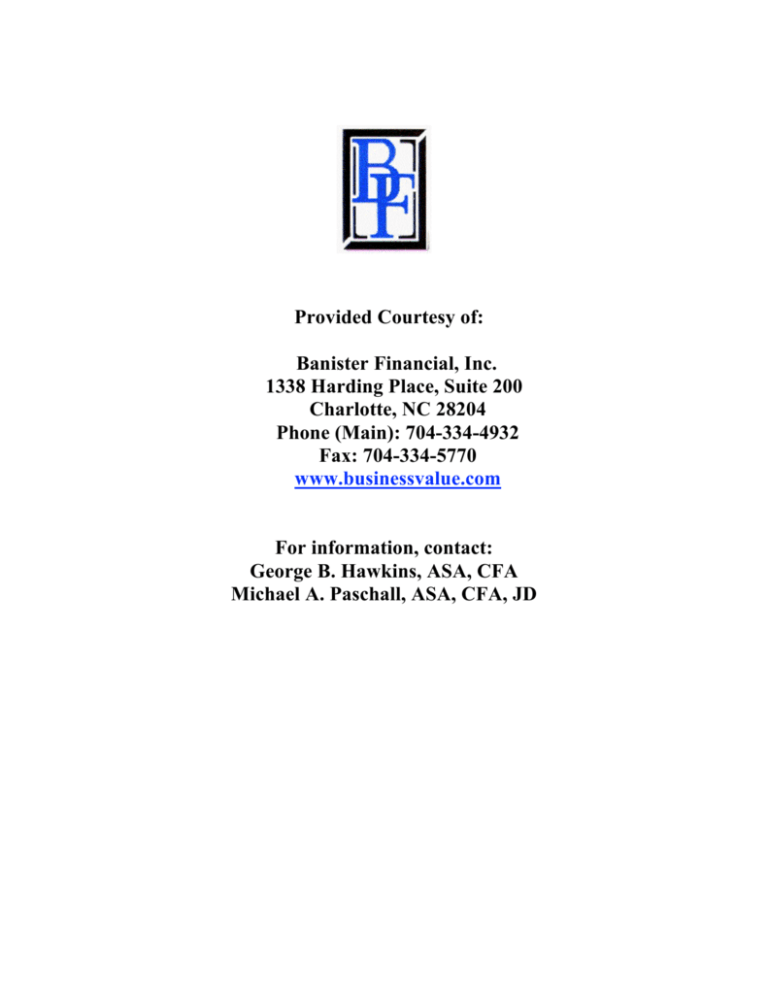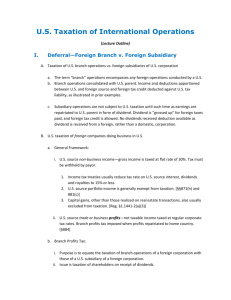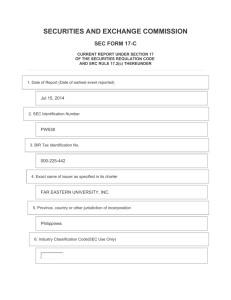Revenue Ruling 83-120 (valuation of preferred stock)
advertisement

Provided Courtesy of: Banister Financial, Inc. 1338 Harding Place, Suite 200 Charlotte, NC 28204 Phone (Main): 704-334-4932 Fax: 704-334-5770 www.businessvalue.com For information, contact: George B. Hawkins, ASA, CFA Michael A. Paschall, ASA, CFA, JD Revenue Ruling 83-120 Internal Revenue Service 1983-2 C.B. 170 Section 2512.-Valuation of Gifts 26 CFR 25.2512-2: Stocks and bonds. (Also Sections 305, 351, 354, 368, 2031; 1.305-5, 1.351-1, 1.354-1, 1.368-1, 20.2031-2.) Valuation; stock; closely held busi-ness . The significant factors in deriv-ing the fair market value of pre-ferred and common stock received in certain corporate reorganizations are discussed. Rev. Rul. 59-60 am-plified. Rev. Rul. 83-120 SECTION 1. PURPOSE The purpose of this Revenue Rul-ing is to amplify Rev. Rul. 59-60, 1959-1 C.B. 237, by specifying addi-tional factors to be considered in valuing common and preferred stock of a closely held corporation for gift tax and other purposes in a recapital-ization of closely held businesses. This type of valuation problem fre-quently arises with respect to estate planning transactions wherein an individual receives preferred stock with a stated par value equal to all or a large portion of the fair market value of the individual's former stock interest in a corporation. The individ-ual also receives common stock which is then transferred, usually as a gift, to a relative. Sec. 2. BACKGROUND .01 One of the frequent objectives of the type of transaction mentioned above is the transfer of the potential appreciation of an individual's stock interest in a corporation to relatives at a nominal or small gift tax cost. Achievement of this objective re-quires preferred stock having a fair market value equal to a large part of the fair market value of the individ-ual's former stock interest and com-mon stock having a nominal or small fair market value. The approach and factors described in this Revenue Rul-ing are directed toward ascertaining the true fair market value of the com-mon and preferred stock and will usually result in the determination of a substantial fair market value for the common stock and a fair market value for the preferred stock which is substantially less than its par value. .02 The type of transaction re-ferred to above can arise in many dif-ferent contexts. Some examples are: (a) A owns 100% of the common stock (the only outstanding stock) of Z Corporation which has a fair market value of 10,500x. In a recapitalization described in section 368(a)(1)(E), A receives preferred stock with a par value of 10,000x and new common stock, which A then transfers to A's son B. (b) A owns some of the common stock of Z Corporation (or the stock of several corpora-tions) the fair market value of which stock is 10,500x. A transfers this stock to a new cor-poration X in exchange for preferred stock of X corporation with a par value of 10,000x and common stock of corporation, which A then transfers to A's son B. (c) A owns 80 shares and his son B owns 20 shares of the common stock (the only stock outstanding) of Z Corporation. In a recapital-ization described in section 368(a)(1)(E), A ex-changes his 80 shares of common stock for 80 shares of new preferred stock of Z Corporation with a par value of 10,000x. A's common stock had a fair market value of 10,000x. SEC. 3. GENERAL APPROACH TO VALUATION Under section 25.2512-2(f)(2) of the Gift Tax Regulations, the fair market value of stock in a closely held corporation depends upon numerous factors, including the corporation's net worth, its prospective earning power, and its capacity to pay divi-dends. In addition, other relevant factors must be taken into account. See Rev. Rul. 59-60. The weight to be accorded any evidentiary factor de-pends on the circumstances of each case. See section 25.25122(f) of the Gift Tax Regulations. SEC. 4. APPROACH TO VALUATION-PREFERRED STOCK .01 In general the most important factors to be considered in determining the value of preferred stock are its yield, dividend coverage and protec-tion of its liquidation preference. .02 Whether the yield of the pre-ferred stock supports a valuation of the stock at par value depends in part on the adequacy of the dividend rate. The adequacy of the dividend rate should be determined by comparing its dividend rate with the dividend rate of high-grade publicly traded preferred stock. A lower yield than that of high-grade preferred stock in-dicates a preferred stock value of less than par. If the rate of interest charged by independent creditors to the corporation on loans is higher than the rate such independent cred-itors charge their most credit worthy borrowers, then the yield on the pre-ferred stock should be corresponding-ly higher than the yield on high qual-ity preferred stock. A yield which is not correspondingly higher reduces the value of the preferred stock. In addition, whether the preferred stock has a fixed dividend rate and is non-participating influences the value of the preferred stock. A publicly traded preferred stock for a company having a similar business and similar assets with similar liquidation preferences, voting rights and other similar terms would be the ideal comparable for de-termining yield required in arms length transactions for closely held stock. Such ideal comparables will frequently not exist. In such circum-stances, the most comparable public-ly-traded issues should be selected for comparison and appropriate adjust-ments made for differing factors. .03 The actual dividend rate on a preferred stock can be assumed to be its stated rate if the issuing corpora-tion will be able to pay its stated divi-dends in a timely manner and will, in fact, pay such dividends. The risk that the corporation may be unable to timely pay the stated dividends on the preferred stock can be measured by the coverage of such stated dividends by the corporation's earnings. Cover-age of the dividend is measured by the ratio of the sum of pre-tax and pre-interest earnings to the sum of the to-tal interest to be paid and the pre-tax earnings needed to pay the after-tax dividends. Standard & Poor's Ratings Guide, 58 (1979). Inadequate cover-age exists where a decline in corporate profits would be likely to jeopardize the corporation's ability to pay divi-dends on the preferred stock. The ratio for the preferred stock in ques-tion should be compared with the ratios for high quality preferred stock to determine whether the preferred stock has adequate coverage. Prior earnings history is important in this determination. Inadequate coverage indicates that the value of preferred stock is lower than its par value. Moreover, the absence of a provision that preferred dividends are cumula-tive raises substantial questions con-cerning whether the stated dividend rate will, in fact, be paid. According-ly, preferred stock with noncumula-tive dividend features will normally have a value substantially lower than a cumulative preferred stock with the same yield, liquidation preference and dividend coverage. .04 Whether the issuing corpora-tion will be able to pay the full liqui-dation preference at liquidation must be taken into account in determining fair market value. This risk can be measured by the protection afforded by the corporation's net assets. Such protection can be measured by the ratio of the excess of the current mar-ket value of the corporation's assets over its liabilities to the aggregate liquidation preference. The protec-tion ratio should be compared with the ratios for high quality preferred stock to determine adequacy of coverage. Inadequate asset protection exists where any unforeseen business reverses would be likely to jeopardize the corporation's ability to pay the full liquidation preference to the holders of the preferred stock. .05 Another factor to be con-sidered in valuing the preferred stock is whether it has voting rights and, if so, whether the preferred stock has voting control. See, however, Section 5.02 below. .06 Peculiar covenants or provi-sions of the preferred stock of a type not ordinarily found in publicly traded preferred stock should be care-fully evaluated to determine the ef-fects of such covenants on the value of the preferred stock. In general, if covenants would inhibit the market-ability of the stock or the power of the holder to enforce dividend or liquidation rights, such provisions will reduce the value of the preferred stock by comparison to the value of preferred stock not containing such convenants or provisions. .07 Whether the preferred stock contains a redemption privilege is an-other factor to be considered in deter-mining the value of the preferred stock. The value of a redemption privilege triggered by death of the preferred shareholder will not exceed the present value of the redemption premium payable at the preferred shareholder's death (i.e., the present value of the excess of the redemption price over the fair market value of the preferred stock upon its issuance). The value of the redemption privilege should be reduced to reflect any risk that the corporation may not possess sufficient assets to redeem its pre-ferred stock at the stated redemption price. See .03 above. SEC. 5. APPROACH TO VALUATION- COMMON STOCK .01 If the preferred stock has a fixed rate of dividend and is nonpar-ticipating, the common stock has the exclusive right to the benefits of fu-ture appreciation of the value of the corporation. This right is valuable and usually warrants a determination that the common stock has substan-tial value. The actual value of this right depends upon the corporation's past growth experience, the economic condition of the industry in which the corporation operates, and general economic conditions. The factor to be used in capitalizing the corpora-tion's prospective earnings must be determined after an analysis of nu-merous factors concerning the corpo-ration and the economy as a whole. See Rev. Rul. 59-60, at page 243. In addition, after-tax earnings of the corporation at the time the preferred stock is issued in excess of the stated dividends on the preferred stock will increase the value of the common stock. Furthermore, a corporate policy of reinvesting earnings will also increase the value of the common stock. .02 A factor to be considered in determining the value of the common stock is whether the preferred stock also has voting rights. Voting rights of the preferred stock, especially if the preferred stock has voting con-trol, could under certain circum-stances increase the value of the pre-ferred stock and reduce the value of the common stock. This factor may be reduced in significance where the rights of common stockholders as a class are protected under state law from actions by another class of shareholders, see Singer v. Magnavox Co., 380 A.2d 969 (Del. 1977), par-ticularly where the common share-holders, as a class, are given the power to disapprove a proposal to al-low preferred stock to be converted into common stock. See ABA-ALI Model Bus. Corp. Act, Section 60 (1969). SEC. 6. EFFECT ON OTHER REVENUE RULINGS Rev. Rul. 59-60, as modified by Rev. Rul. 65-193, 1965-2 C.B. 370 and as amplified by Rev. Rul. 77-287, 1977-2 C.B. 319, and Rev. Rul. 80-213, 1980-2 C.B. 101, is further am-plified.






